49-Year-Old USCG Icebreaker Polar Star Departs Antarctic Region

U.S. Coast Guard Cutter Polar Star (WAGB 10) and crew departed the Antarctic region Tuesday after 65 days south of the Antarctic Circle in support of Operation Deep Freeze 2025.Operation Deep Freeze is an annual event, led by the U.S. Antarctic Program (USAP) in conjunction with the Department of Defense, to support the U.S. National Science Foundation (NSF). The USAP advances the nation’s goals to support the Antarctic Treaty, fosters cooperative research with other nations, protects Antarctic resources…
US' Sole Heavy Icebreaker Arrives in Antarctica
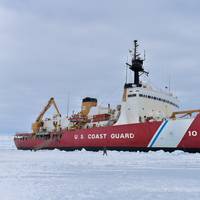
The 157 crewmembers of the U.S. Coast Guard Cutter Polar Star (WAGB 10) arrived at McMurdo Station in Antarctica Monday following an 86-day transit from the United States and the cutter’s departure from its Seattle homeport Nov. 13.This deployment marks the Polar Star’s 25th journey to Antarctica supporting Operation Deep Freeze, an annual joint military service mission to resupply the United States Antarctic stations in support of the National Science Foundation, lead agency for the United States Antarctic Program.Each year…
USCG PSC Equals meaningful Polar Presence
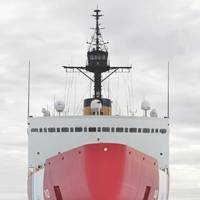
The Coast Guard needs a ship that can do more than just break ice; it needs a multi-mission ship to provide for the nation’s security, asserting its sovereign rights, and protecting its long-term economic interests. That ship is the Polar Security Cutter.Since Russia cashed the check in 1867 for the purchase of Alaska the U.S. has been an Arctic nation. Today, it is one of eight countries that have territorial land or seas above the Arctic Circle or in the polar region (six of those countries have Arctic Ocean coastline or an exclusive economic zone above the Arctic Circle). The U.S.
Coast Guard Icebreaker Completes 129-day Arctic Deployment
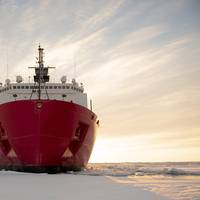
The crew of the U.S. Coast Guard Cutter Healy returned home Friday to their homeport in Seattle following a four-month deployment in the Arctic. In addition to providing presence and access in the Arctic during the 129-day summer deployment, the Healy crew completed three research missions in partnership with the National Science Foundation, the National Oceanic and Atmospheric Administration and the Office of Naval Research, conducting physical and biological research in the Arctic Ocean.
The US Government Must Fund Icebreakers Now
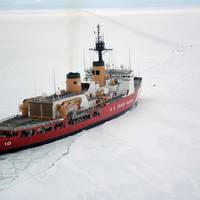
Congress last funded the purchase of polar icebreakers for the U.S. Coast Guard in the early 1970s. The USCCG Polar Star (WAGB-10) was commissioned in 1976, followed by the USCGC Polar Sea (WAGB-11) in 1977. Polar Sea has been out of service since 2010 due to a major engine failure. Polar Star was ‘in commission, special’ status from 2008 through 2012 while undergoing a service life extension. It is currently the only active heavy polar icebreaker in the U.S. fleet. The less capable USCGC Healy (WAGB-20) is a medium icebreaker and is equipped to support research missions in polar waters.
Antarctic Rescue Mission Underway

Emergency responders have launched an urgent rescue mission to Antartic waters to evacuate a cruise ship passenger who is suspected to have suffered a stroke early Monday morning. Working closely with the U.S. Antarctic Program and the vessel’s operator and crew, Rescue Coordination Centre New Zealand (RCCNZ) is coordinating the medevac after receiving a call from the expedition cruise ship MV Ortelius located in the Ross Sea, off the Antarctic ice shelf, 3,600 km south of New Zealand.
America Needs Icebreakers
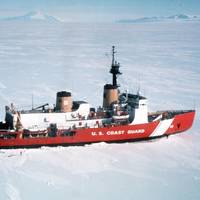
Russia has more polar icebreakers than the rest of the world combined. America has one polar icebreaker and that one is well past its prime. There has been talk of sharing icebreakers. Sharing may work with allies, who are generally on the same page. Sharing will not work with Russia, which views the world as a zero-sum game. In June 2016, Russia announced the launching of Arktika, the world’s largest polar icebreaker. With a full load displacement of 33,540 tons, a length of 173.3 meters and a breadth of 34 meters, it will be capable of breaking ice up to 2.9 meters.
This Day In Naval History: July 13
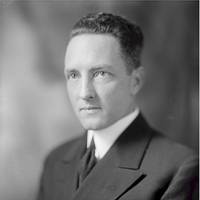
1812 - The frigate, USS Essex, commanded by Capt. David Porter, captures the merchant brig, Lamprey, in the Atlantic. 1854 - The sloop of war, USS Cyane, bombards San Juan del Norte (Greytown), Nicaragua, in retaliation for ill-treatment of U.S. citizens. Marines and Sailors also seize weapons and powder in retribution for an attack on U.S. Consular officials for U.S. refusal to pay reparation. 1939 - Rear Adm. Richard Byrd is appointed to command the 1939-1941 U.S. Antarctic Service Expedition. Under objectives outlined by President Franklin D.
US Polar Icebreaker Visits San Diego
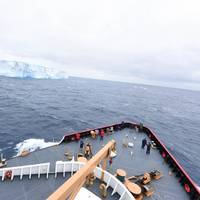
The U.S. Coast Guard’s polar icebreaker Cutter Polar Star has made a brief stop in a warmer climate, mooring in San Diego before returning to Seattle after a four and a half month-long deployment to the Antarctic in support of Operation Deep Freeze 2016. The Polar Star, a 399-foot cutter commissioned in 1976, is the nation’s only operational heavy icebreaker, and the most powerful non-nuclear icebreaker in the world. The cutter recently delivered necessary cargo to sustain the National Science Foundation managed U.S. Antarctic Program’s McMurdo and South Pole stations for the next year.
Icebreaker Returns from Antarctic Rescue
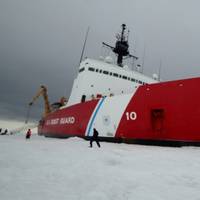
The crew of Coast Guard Cutter Polar Star, the United States’ only operational heavy icebreaker, is scheduled to return to Seattle after a 101-day Antarctic deployment Tuesday. Polar Star’s crew departed Seattle for Operation Deep Freeze 2015, the military resupply and logistical support mission for the U.S. Antarctic Program’s McMurdo Station. Coast Guardsmen aboard Polar Star escorted the cargo vessel Ocean Giant and fuel tanker Maersk Peary to McMurdo Station through ice ranging in thickness from 5 to 10 feet. These logistics allow scientific research to continue in the Antarctic.
U.S. Coast Guard Rescues 26 in Antarctic
The U.S. Coast Guard has rescued an Australian fishing vessel carrying 26 people that had been stranded in icy Antarctic seas since last week, the Coast Guard said on Tuesday. The crew was saved on Sunday by the Coast Guard cutter Polar Star, which broke through some 150 miles (240 km) of thick ice on its way to the 207-foot (63-meter) Antarctic Chieftain vessel, the Coast Guard said in a statement. The Chieftain had been stuck about 900 miles (1,450 km) northeast of McMurdo Sound since last Tuesday, after damaging three of its four propellers in the ice, the Coast Guard said. "There were some very happy sailors aboard Antarctic Chieftain upon our arrival," Polar Star commanding officer, Captain Matthew Walker, said in a statement.
Coast Guard Rescue Underway in Antarctica

A U.S. Coast Guard crew is en route to assist a 207-foot fishing vessel with 26 people aboard beset in ice approximately 900 miles northeast of McMurdo Sound, Antarctica. The crew of the Coast Guard Cutter Polar Star is attempting to reach the crew of an Australian-flagged fishing vessel, Antarctic Chieftain, who contacted Rescue Coordination Centre New Zealand Tuesday evening for assistance after becoming trapped in the Antarctic ice. The crew of 40-year-old cutter has reported heavy, snow, wind and ice conditions at times as well as large icebergs along their course.
US Coast Guard to Free Aussie Fishing Vessel from Antarctic Ice
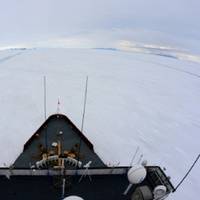
A U.S. Coast Guard cutter has been diverted from its path to rescue a 207-foot fishing vessel stuck in Antarctic ice, the US Coast Guard announced in a press release today. Antarctic Chieftain, an Australian-flagged fishing vessel with 27 passengers, contacted Rescue Coordination Centre New Zealand after becoming beset in ice 900 miles Northeast of McMurdo Sound, Antarctica on Tuesday. The vessel suffered damage to three of its four propeller blades when it became stuck in the ice and lost its ability to maneuver. RCC New Zealand diverted U.S.
Coast Guard Cutter Departs for Antarctic Mission
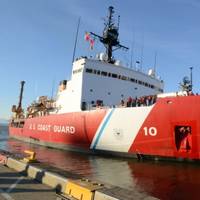
The nation’s only heavy icebreaker departed Seattle Sunday for a four-month mission to Antarctica as part of Operation Deep Freeze, the annual Joint Task Force Support to resupply the National Science Foundation outpost there. The crew of Coast Guard Cutter Polar Star from Coast Guard Base Seattle will head to McMurdo Sound in support the U.S. Antarctic Program and the National Science Foundation. This mission will require the cutter’s crew to break through more 12 miles of ice in McMurdo Sound, sometimes as much as 10 feet in thickness, to resupply McMurdo Science Station.
House Subcommittee Hearing Highlights “Dismal State” of U.S. Icebreaking Capability

At the July 23, 2014, hearing of the House Subcommittee on Coast Guard and Maritime Transportation on “Implementing U.S. Policy in the Arctic” the committee chairman, Rep. Duncan Hunter (R-CA), opened the proceedings by holding up a graphic of the icebreaker fleets of the world—which depicts nearly 40 Russian icebreakers—and then commented on the “dismal state” of the U.S. icebreaker situation. The hearing background paper noted that the United States presently has only two working polar class icebreakers…
Coast Guard Icebreaker returns from Operation Deep Freeze
The Coast Guard Cutter Polar Star is scheduled to return to their homeport of Coast Guard Base Seattle at 10 a.m., Friday, March 21, 2014, following a 108-day deployment of Operation Deep Freeze 2014. Polar Star departed Seattle Dec. 3rd, 2013, and made port calls in Honolulu, Sydney, Australia, McMurdo Station, Antarctica, and Tahiti, French Polynesia. Having completed a reactivation that began four years ago, this deployment marks the first time in six years that a U.S. icebreaker has supported Operation Deep Freeze, the U.S. Antarctic Program’s resupply efforts of McMurdo Station, Antarctica. In January, Polar Star departed Sydney to assist in the rescue effort of two ships, the Russian vessel Akademik Shokalsiky and the Chinese vessel Xue Long.
Russian, Chinese Vessels Freed from Arctic Ice
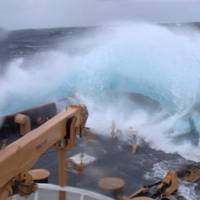
The U.S. Coast Guard Cutter Polar Star was released by the Australian Maritime Safety Authority from search and rescue duties Jan. 7, following confirmation the Russian-Flagged Akademik Shokalskiy and Chinese-Flagged Xue Long are free from the Antarctic ice due to a favorable change in wind conditions. The Coast Guard Pacific Area command center received confirmation from the Australian Maritime Safety Authority at 2 p.m. Pacific Standard Time that both ships broke through the heavy ice, rendering assistance from the Polar Star no longer necessary.
Antarctic Ice-Beset Vessels Await Arrival of US Icebreaker
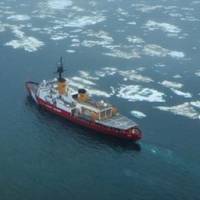
The U.S. Coast Guard Cutter 'Polar Star' is responding to a request from the Australian Maritime Safety Authority (AMSA) to assist the Russian-flagged passenger expedition ship 'Akademik Shokalskiy' and the Chinese-flagged icebreaker 'Xue Long' (which had earlier taken off the passengers from the 'Shokalsky' before becoming beset herself). The Polar Star leaves Sydney today after taking on supplies prior to its voyage to Antarctica, and it is anticipated it will take approximately seven days for the US Coast Guard Cutter to reach Commonwealth Bay, depending upon weather and ice conditions.
Murmansk Shipping to Assist U.S. NSF

Murmansk Shipping Company was selected among other operators of icebreaking fleet by U.S. National Science Foundation (National Science Foundation - NSF) which provides U.S. Antarctic Program. The ice-breaker Vladimir Ignatyuk successfully works in Antarctica, including under the contract with the Center of Ocean and Antarctic Research of the Indian Government at Maitri and Larsemann Hills stations. The ice-breaker Vladimir Ignatyuk will provide services for piloting vessels for American polar explorers in difficult navigational conditions of Southern continent…
Polar Star returns to Seattle
The Coast Guard Cutter Polar Star will be returning to Seattle Tuesday afternoon. The 399-ft., Seattle-based cutter is returning after a five-month deployment where the icebreaker participated in Operation Deep Freeze 2004. Operation Deep Freeze supports the U.S. Antarctic Program and the National Science Foundation by transporting scientists and breaking through ice in order to re-supply the world’s southern-most science stations. As a result of the Polar Star’s efforts, more than 8 million gallons of fuel and 11 million pounds of cargo were safely delivered to the McMurdo Research Station and South Pole Station, which depend on these supplies to operate.
Maersk-Rickmers Performs Heavy-Lifting for U.S. Navy

Maersk-Rickmers U.S. flag heavy-lift project carrier recently lifted and moved two 100+ ton range support craft for the U.S. Navy. The largest craft weighed in at 220 metric tons; both watercraft were lifted by Maersk Texas’ powerful onboard cranes (photo). The vessels were loaded on the U.S. West Coast and traveled across the Pacific to their destinations. Maersk Texas will soon transport U.S.-manufactured power plant equipment destined for Turkey. The equipment was financed by the U.S.
Diamonds—and Shipping—in Antarctica
Kimberlite deposits, igneous rock formations often containing diamonds, have been discovered in Antarctica, according to a report by Nature Communications. And though no diamonds have been discovered, researchers believe they are there, along with other valuable substances. Gold, platinum, copper, iron and coal have already been discovered in Antarctica, and diamond mining has reached many of the coldest regions globally. So is diamond mining in Antarctica a possibility, and how will it affect the commercial maritime industry? By way of the Antarctic Treaty, mining is currently forbidden in the area, and the ban is expected, though not entirely certain, to be extended to 2041.
Navy to Christen USNS Richard E. Byrd
The Navy will christen the USNS Richard E. Byrd on May 15. The launching ceremony for the newest ship in the Lewis and Clark class of underway replenishment ships will be held at General Dynamics National Steel and Shipbuilding Company, San Diego. The ship honors Rear Adm. Richard E. Byrd (1888-1957), an explorer famous for his Antarctic expeditions and for leading the first expedition to fly over the North Pole. Like the legendary explorers, Meriwether Lewis and William Clark, for whom the first ship of the class was named, Byrd bravely volunteered to explore one of the most remote and harshest places on earth. Due to his unquenchable thirst for exploration, he provided substantial contributions to the world's understanding of the Antarctic. Following his graduation from the U.S.






